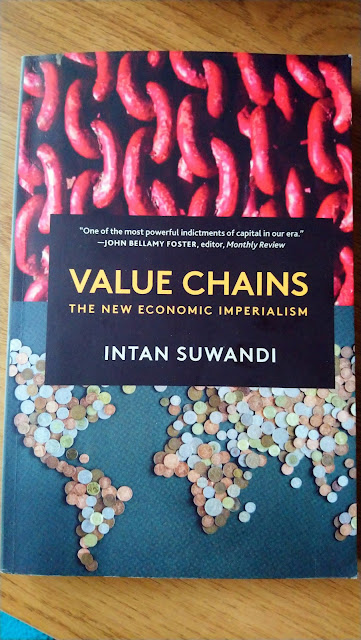Review of The history of business in Africa by Grietjie Verhoef and its importance for the study of capitalist penetration in Africa
Grietjie Verhoef has published a study on the economic history of business or business enterprises in Africa that is most useful for the analysis of the historical penetration of capitalism in that continent. It makes us reformulate what we studied mainly here and here . For example, his analysis of John Sarbah's case in East Africa immediately makes us rethink our claim about African formal and real subsumption: the African merchant, a member of the royal family of one of the eastern African kingdoms, begins to participate directly in the production of palm oil, for its commercialization and sale in the international market (through the European commercial houses installed in the African coasts). That means that the Sarbah case is not simply or exclusively one of a commercial exchange of surplus produced by direct producers, nor the obtaining of an absolute rent without relative surplus value (all of which would place these processes within a formal subsumption), but in addition to all those correct characteristics, is the fact of being an agricultural entrepreneur who modifies the labor process (which means it is relative surplus value), and therefore, is a case of real capitalist subsumption at the beginning of the 20th century. The same is detailed by Verhoef in other cases where traders all across Africa make the transition to capitalist agricultural production, always under the mediation of the aristocracy of African tribal kingdoms at the beginning of the century.
Now, the character of traders who operate as intermediaries of direct agricultural producers who maintain traditional and customary tribal and cosanguineal relations is maintained, but through the capitalist exploitation of agricultural labor. That is to say, the real subsumption that we still placed as occurring later in Africa, is really earlier, and the process of Belgian, British, French, Portuguese and German colonization themselves, are since the beginning, penetrations of agricultural capitalism. This is what Verhoef himself details once more when analyzing colonization: colonization did not begin first with the direct administration of the colonies, but with the establishment of commercial capitalist companies, which would relate to private and state or royal African companies and commercial capital, and these in turn with intermediate traders to reach direct producers and consumers in the internal areas of the continent (through various modes of commercial infrastructure, etc -from nomadism to maritime trade-). This is due to the need of establishing the commercial oligopoly (due to the fact that the European merchants and companies manage to negotiate directly with tribes and peoples of diverse internal or coastal regions of Africa) that see the need of paying for the direct colonial administration of the territories, and the history of colonialism that we all know.
Private companies will mix with the production and commercialization of traditional tribal and communal leaders, but always through royal permission, and after colonization, through the colonial commercial administration. Verhoef's work, therefore, the most detailed in describing the African commercial and agricultural processes, then demonstrates precisely the second way of transition from pre-capitalism to capitalism in chapter XX of Volume III of Capital, confirming all our research: it is a commercial capital that appropriates agricultural and incipient-manufacturing production from above, both in the period prior to the establishment of direct colonial administration, and in the colonial period itself. The reading of the first text still holds , and the conclusions or modifications of this second are included, which we quote: "With the inclusion of Southeast and South Asia, we see that we have to refine some things: the definition of Latin America can be maintained as such and as it is (always remembering that we are talking about a very general level, and that there are internal degrees and exceptions to all this), but it is altered by the fact that Asian and African rent makes an approachment of the landowner towards the modification of production, which in addition to bring it closer ambiguously to absolute surplus value (as a partial owner), it also brings it closer to relative surplus value (as organizer of the division of labor or provider of raw materials and fixed capital)." We confirm with Verhoef that this approach to absolute and relative rent, is not simply an approach, but the historical reality of the development of agrarian capitalism in Africa.
The reason why the book allows us to identify these elements, is because of it’s outlook on comercial capital. Without a doubt is one of the most detailed, if not the most detailed account in the literature on the economy in Africa, related to the subject of commercial capital, and not exclusively on sharecropping peasants or landholders, etc. Although its terminology is economically liberal, for example, considering every form of informal ecnomic participation as ‘entrepeneurship’, hiding the fact that they’re small peasants involved in tribal and traditional customary and cosanguineal relationships, in any case it is detailed enough in historical terms to become one of the primary sources on capitalist development in Africa.


